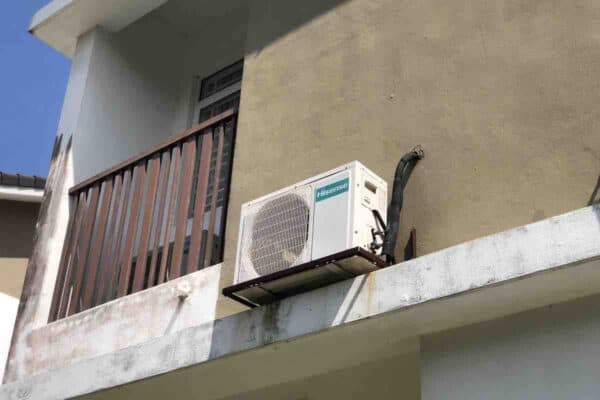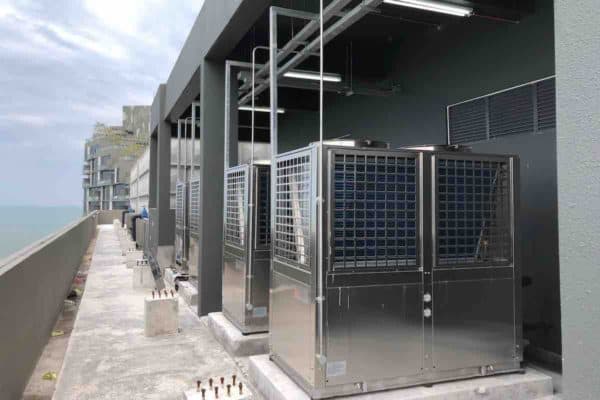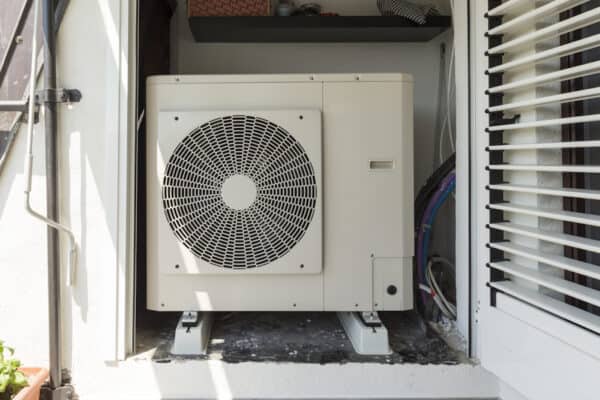Working Principle of Water Source Heat Pumps for Hot Water
Some commercial buildings like hotels and restaurants use a centralized hot water system. Nowadays, people are switching from gas boilers to heat pumps for hot water generation due to the higher energy efficiency offered by heat pumps. So, how do water source heat pumps work?
In commercial hot water systems, water source heat pumps (water-to-water heat pumps) harvest heat from either the condenser water supply line from the cooling tower or the chilled water return line from the chiller to produce hot water through the reversed refrigeration process.
Water source heat pumps are traditionally known to be harvesting heat from groundwater or river water. However, they can also harvest heat from the building’s HVAC chilled water system.
Water Source Heat Pump Heat Harvesting Process
Water source heat pumps can be used for space heating or hot water production. For hot water applications, water source heat pumps are further known as water-to-water heat pumps.
As the name suggests, water-to-water heat pumps harvest energy from water and then transfer the heat to the water as well.
Since water source heat pumps are used to produce hot water, they also harvest heat from the water.
Large commercial buildings such as hotels, shopping malls and hospitals often use a chilled water system for space cooling. Such a system setup provides an opportunity for energy savings using water source heat pumps.
There are two ways a water source heat pump can integrate with a chilled water system as follow:
- Source heat energy from the condenser water return line
- Source heat energy from the chilled water supply line
By harvesting the heat energy from either the chilled water return line or the condenser water supply line, water source heat pumps essentially run on “free energy” while improving the efficiency of the chilled water system at the same time.
Hence, such hot water and chilled water combo improve the overall energy efficiency of space cooling and hot water production in buildings.
Condenser Water Source Heat Pump
Water source heat pumps can harvest heat from the condenser water supply line to produce hot water. The condenser water supply line is the condenser water that is leaving the cooling tower and entering the chiller.
Usually, the condenser water supply temperature is around 30°C (86°F). Water source heat pumps take in a small amount of the condenser water based on the required water flow rate and return it back to the condenser water supply line at around 25°C (77°F).
The delta T of the condenser water sourcing process is around 5°C (9°F).
Below is a diagram that illustrates the condenser water sourcing process of a water source heat pump:

As the water source loop is having a delta T of 5°C (9°F), the hot water loop is also having the same delta T.
From the above hot water system setup, the hot water storage tank is always filled with cold water at around 26°C (79°F) depending on the location.
Then, the hot water pump will circulate the cold water through the water source heat pump with a temperature increase of 5°C (9°F) for every loop.
Gradually, the cold water gets heated up by the water source heat pump until it reaches 60°C (140°F).
Since the hot water loop is rejecting heat to increase the water temperature, the other end needs to absorb heat. Hence, the source water pump circulates the condenser water through the water source heat pump.
The condenser water releases heat to the water source heat pump and returns back to the condenser water supply line at around 25°C (77°F).
As the main condenser water supply line mixes with the condenser water from the water source heat pump, the condenser water enters the chiller at a slightly lower temperature.
Chiller efficiency increases when the condenser water supply temperature reduces. See my post How Chilled Water Temperature Affects Chiller Performance? for a detailed explanation.
Therefore, condenser water source heat pumps not only harvest “free energy” but also improve chiller efficiency.
Chilled Water Source Heat Pump
Water source heat pumps also can harvest heat energy from the chilled water return line. The chilled water return line is the chilled water that is entering the chiller.
Usually, the chilled water return temperature is around 12.2°C (54°F). Water source heat pumps take in a small amount of the chilled water based on the required water flow rate and return it back to the chilled water return line at around 9.2°C (49°F).
The delta T of the chilled water sourcing process is around 3°C (5°F).
Below is a diagram that illustrates the chilled water sourcing process of a water source heat pump:
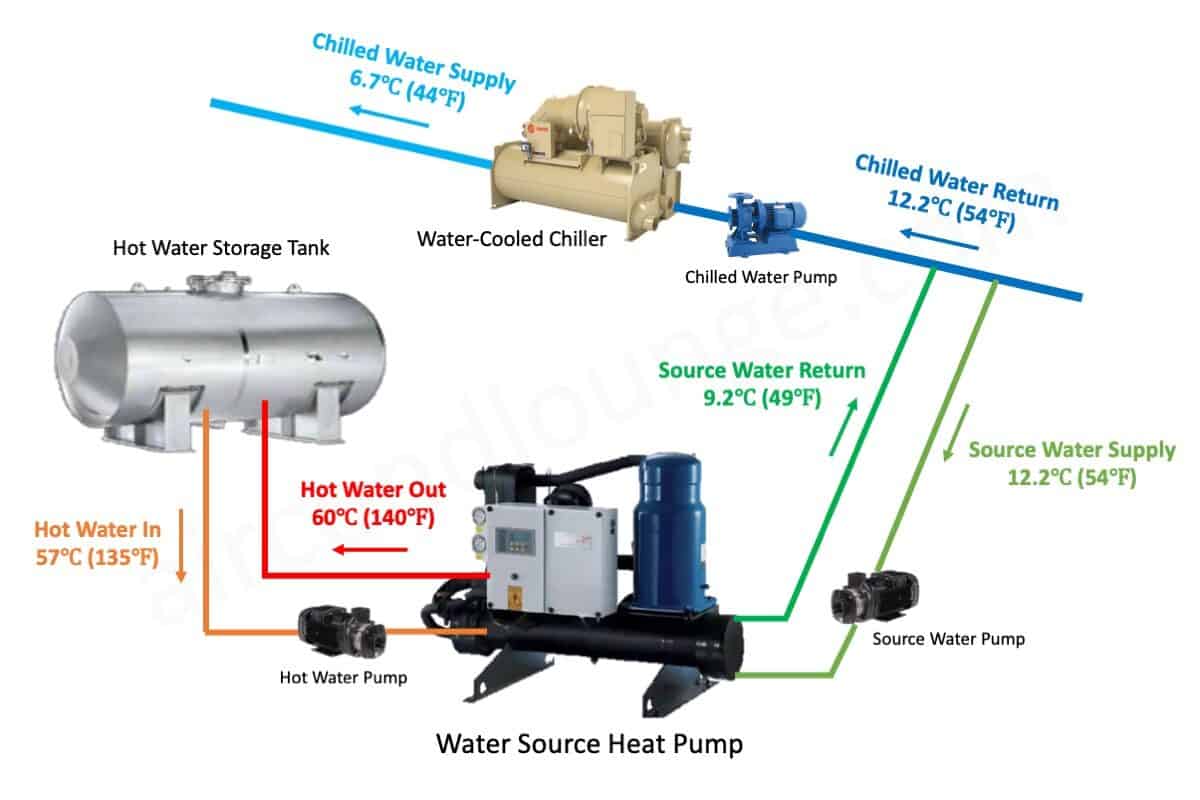
As the water source loop is having a delta T of 3°C (5°F), the hot water loop is also having the same delta T.
In this setup, the source water pump draws in the chilled water from the chilled water return line at around 12.2°C (54°F) and passes it through the water source heat pump for heat absorption.
The chilled water exchanges heat with the refrigerant in the shell-and-tube heat exchanger and return back to the main chilled water return line at around 9.2°C (49°F).
As the main chilled water return line mixes with the chilled water from the water source heat pump, the chilled water enters the chiller at a slightly lower temperature.
Normally, a low chilled water return temperature is not good for the chiller. However, in this case, the water source heat pump is virtually decreasing the heat load. Hence, the chiller does not need to work as hard.
So, the chiller itself may not show improved efficiency but decreased overall energy usage.
How Water Source Heat Pumps Work?
A typical water source heat pump for hot water production is made of 4 major components; a) a compressor, b) an expansion valve, c) an evaporator and d) a condenser.
The compressor of a water source heat pump is often a scroll type compressor.
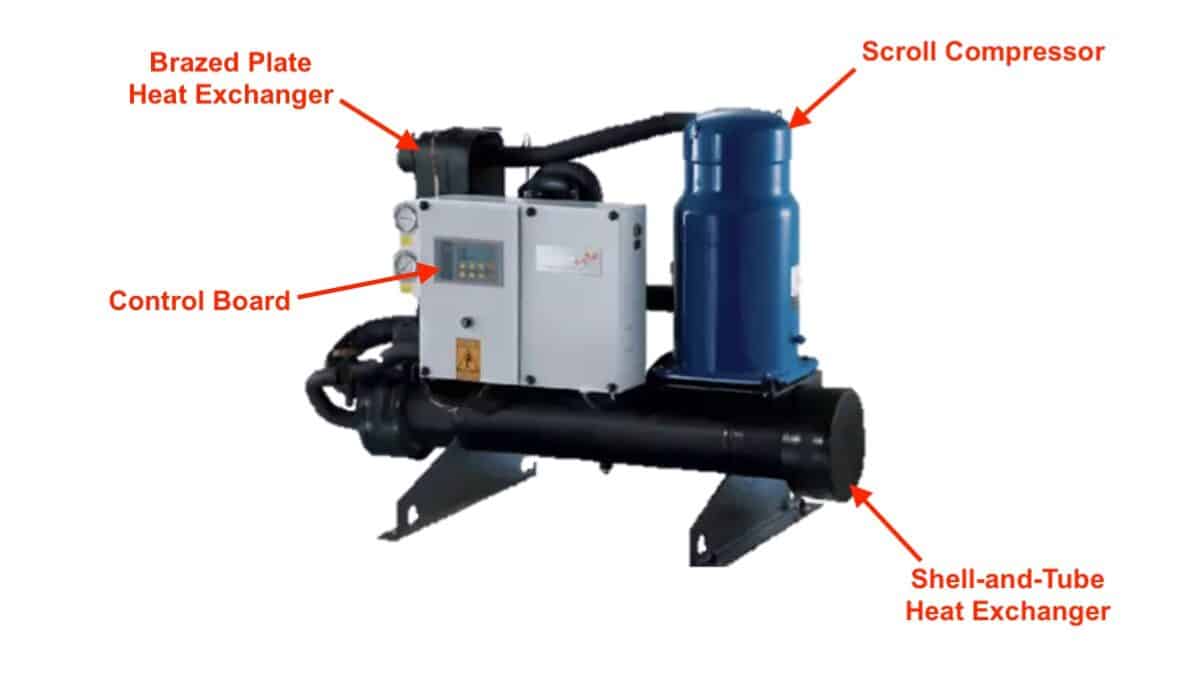
A large hotel building with a little over 250 guest rooms may need about 550 kW (156 RT) of hot water production capacity. A typical water source heat pump can go up to 120 kW (34 RT) with four 12 HP scroll compressors.
Hence, the hotel needs more than four 120 kW (34 RT) water source heat pumps with more than 16 scroll compressors in total.
Water source heat pumps use the reversed refrigeration cycle to produce hot water.
A standard hot water heat pump system will have the cold water goes to the hot water storage tank first. Then, the cold water is pumped to the condenser of the water source heat pump for water heating.
The condenser of the water source heat pump is often a brazed plate heat exchanger with a double wall. The hot refrigerant gas discharged from the compressor heats up the cold water inside the heat exchanger.
Then, the cold water turns into warm water and cycles through the process until it gets to the desired hot water temperature.
Usually, the ideal hot water storage temperature is between 55°C (131°F) and 60°C (140°F).
Meanwhile, the hot refrigerant gas condenses and turns into liquid refrigerant before it is expanded by the expansion valve and becomes cold refrigerant mixtures at the evaporator.
The evaporator of the water source heat pump is often a shell-and-tube heat exchanger.
As the source water pump circulates either the condenser water or the chilled water through the heat exchanger, the cold refrigerant mixtures absorb the heat energy and turn it into gas refrigerant before it goes back into the compressor and repeats the cycle.
Since the source water temperature (chilled water or condenser water) is changing all the time, water source heat pumps have a control system to prevent freezing and tripping.
Condenser Water Source vs Chilled Water Source
A water source heat pump that uses condenser water often looks exactly the same as the one using chilled water as the heat source.
However, due to the lower temperature, the chilled water source flow rate is about twice as much as the condenser water source flow rate.
Perhaps, the most significant difference between sourcing from chilled water versus condenser water is the efficiency of the water source heat pump.
A typical condenser water source heat pump may have an average COP of nearly 5 while a standard chilled water source heat pump may only have an average COP of around 3.
However, the cost of the water source heat pump itself can be cheaper if the source water is chilled water because it can be located indoors as opposed to the one using the condenser water which is often located outdoor where weatherproof materials are needed.
On the flip side, chilled water source heat pumps are more prone to freezing as the water temperature itself is already near the freezing point. So, a slight undercharge of refrigerant may cause freezing.
Next up, learn about what is an air source heat pump and compare the differences.
Related Questions
- What temperature should the water be for a water source heat pump? The temperature of the chilled water and the condenser water for a water source heat pump is around 12.2°C (54°F) and 30°C (86°F) respectively.
- What is the difference between a heat pump and a water source heat pump? A heat pump is conventionally known as an air source heat pump where heat is harvested from the ambient air. Whereas, a water source heat pump harvests heat from either the chilled water, the condenser water or other forms of water.
- Is a water source heat pump better than an air source heat pump? From an energy efficiency perspective, water source heat pumps are better than air source heat pumps.
If you have anything to add (or ask) about this topic, leave a comment down below!





